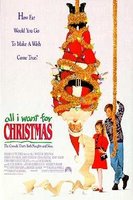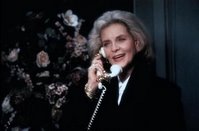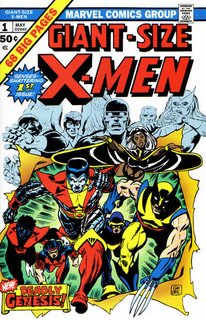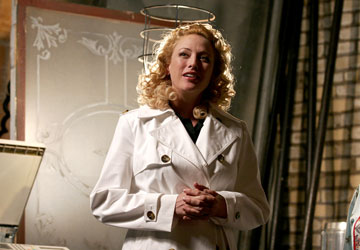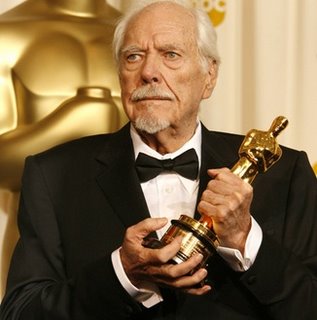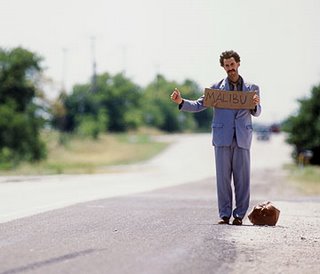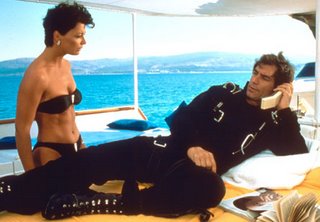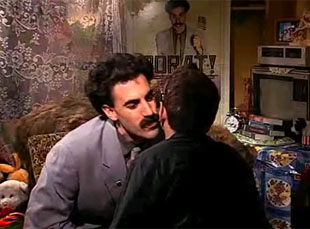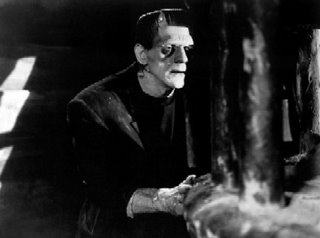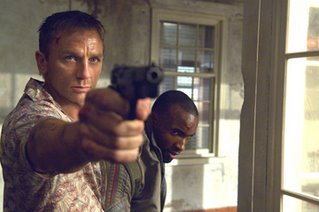 Entertainment Weekly
Entertainment Weekly loves its lists — and, frankly, so do I. This week's cover story ranks the 20 Bond films in order of quality (
link). And would you believe I wasn't satisfied with their choices? I know, shocking, right?
Here's their list:
1)Goldfinger (1964)
2)You Only Live Twice (1967)
3)Live and Let Die (1973)
4)Thunderball (1965)
5)On Her Majesty's Secret Service (1969)
6)Dr. No (1963)
7)GoldenEye (1995)
8)From Russia With Love (1963)
9)The Spy Who Loved Me (1977)
10)For Your Eyes Only (1981)
11)Diamonds Are Forever (1971)
12)Die Another Day (2002)
13)Moonraker (1979)
14)Tomorrow Never Dies (1997)
15)A View to a Kill (1985)
16)The Living Daylights (1987)
17)The Man With the Golden Gun (1974)
18)Octopussy (1983)
19)Licence to Kill (1989)
20)The World is Not Enough (1999)
Goldfinger is an easy number one.
Licence to Kill and
The World is Not Enough likewise easy basement dwellers, though I'd put
A View to a Kill as slightly more dreadful than either of those two (The only two Bonds I have not seen are #s 17 & 18 on this list, both Moore entries, though I have it from sources I trust better than
EW that
TMWTGG is actually not entirely terrible). And as
my post last week indicated, I'm a big Timothy Dalton and
Living Daylights fan, even though this list gives TD no respect and tosses plenty of cheap jokes in at his expense (Dude, isn't that what George Lazenby is for?)
What has me all in a tizzy are those #2 and #3 choices. Besides the fact that I don't think either is particularly good (though
Live and Let Die may be Moore's best), they are both, unquestionably, the most embarassingly racist of any of Bond's adventures. Author Benjamin Svetkey acknowledges
LaLD shortcomings, but just barely, remarking "Ignore the uncomfortable racial undertones...and savor some of the niftiest gadgets and cleverest action beats of the entire series." Yes, viewers, by all means. Ignore the movie's implication that every African-American in the city of New York is part of a giant criminal syndicate, and the concurrent suggestion that every black person in the world is a voodoo-practicing, murderering, paranoid psychotic. If you can get past that, hey, what a romp!
(Side note: I'm not entirely convinced Svetkey watched all of LaLD
. He suggests it has some of the niftiest gadgets of all the Bonds, yet Bond really has only one tame gadget in the entire film [a magnetic watch] and never even gets a visit from Q where we get to see all his fun crackpot ideas blow up as lab assistants run scurrying for their lives.)You Only Live Twice isn't quite as unsavory as
LaLD, but it's not far off. In that one Bond travels to Japan and, in a good example of what passes as "spying" in most Bond pictures, has cosmetic surgery to make himself look Japanese, which means, as depicted here, to look like Mr. Spock without the pointy ears. But Blofeld lives in a great Ken Adam set so, I guess, it's all good.
Look, picking the best Bond movies (after basically
Goldfinger) is totally a matter of preference: with very few exceptions they are all exactly the same. Someone, can't remember who, recently said to me that the Bond you discover right at the cusp of puberty is the one you'll probably like most the rest of your life, as good as theory as any to explain why
GoldenEye, the first Bond I ever saw in a movie theater, remains one of my absolute favorites. Mostly, I'm just annoyed that this list seems largely haphazard and its scale of quality constantly changes.
The World is Not Enough is #20 on the list because of its convoluted plot — and rightfully so. But
On Her Majesty's Secret Service is ranked #5 and Svetkey gives no mention of its totally preposterous storyline: where Bond goes "undercover" in Blofeld's Swiss Alps lair where Blofeld, who just fought Bond face to face in
You Only Live Twice doesn't recognize Bond because he's wearing glasses ("The name's Kent. Clark Kent."). Blofeld's master plan: to hypontize a bunch of Playboy bunnies who will, in turn, destroy the world's food supply. Uh huh.
He also applauds
OHMSS's love plot as the only real one in the series, then makes fun of
The Living Daylights later because it portrays Bond as monogamous, without mentioning that he's monogamous because the movie
is a real love story!!! He also helpfully leaves out that the truly romantic
OHMSS begins with a scene where the Bond girl's father demand Bond marry his daughter and dominate her and make love to her until she falls in love with him. Swoon!
Just a reminder that, fun as these lists are, they're pretty much full of crap.
Labels: James Bond



